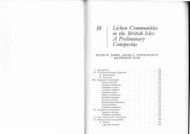Create successful ePaper yourself
Turn your PDF publications into a flip-book with our unique Google optimized e-Paper software.
quinone containing yellow to red colored part <strong>of</strong><br />
the Caloplaca species react blue-red with KOH.<br />
The genus in certain groups still<br />
taxonomically unclear is represented in central<br />
Europe by perhaps 50, in Germany with ca. 75<br />
species, <strong>of</strong> which however not a few are<br />
insufficiently known. The individual species<br />
reside on truly variable substrate, which mostly<br />
are however dependent on basic, subneutral or<br />
weakly acid conditions. Many are found on<br />
distinctly nutrient rich habitats, such as the<br />
calciphytic rock lichens C. citrina, C. decipiens,<br />
C. coronata, and C. ruderum. In addition C.<br />
alociza, C. arnoldii, c. aurantica, C. chalybaea,<br />
C. cirrochroa, c. dolomitica, C. flavescens, C.<br />
granulosa, C. holocarpa, C. lactea, C. ochracea,<br />
C. polycarpa, C. saxicola, C. variabilis and<br />
identified from the Allgäu C. nubigena and C.<br />
percrocata reside on calcareous rock, commonly<br />
in well lighted habitats. C. proteus is found<br />
predominantly on dolomite. The species C.<br />
teicholyta and C. flavovirescens are typically<br />
limited to calcareous rock. Such substrates are<br />
scarce in the region, however tomb stones, wall<br />
crowns and similar substrates have been used.<br />
On them, new habitats have been found by these<br />
and ecologically related species. C. teicholyta<br />
and C. crenulatella occur almost only on this<br />
kind <strong>of</strong> anthropogenic habitats.<br />
A greater part <strong>of</strong> the epilithic Caloplaca<br />
species tolerate dryness and live on relatively<br />
rain protected, <strong>of</strong>ten warm vertical surfaces and<br />
overhangs. Many species bargain for an<br />
“alternative habitat” a nutrient rich, eutrophic,<br />
rainy habitat (bird roosts, wall crowns etc.), as in<br />
the case <strong>of</strong> C. decipiens, C. saxicola and ( less<br />
pronounced) C. flavescens, in the case <strong>of</strong> others<br />
almost never abandoning the typical niche, such<br />
as C. cirrochroa, C. obliterans, C. proteus, C.<br />
chrysodeta and C. xantholyta.<br />
Silicate rock “favoring” C. arenaria, C.<br />
atr<strong>of</strong>lava, C. crenularia, the C. grimmiae living<br />
as a parasite on Candelariella vitellina as well as<br />
C. irrubescens, C. obliterans, C. scotoplaca, and<br />
C. subpallida: frequently occurring on relatively<br />
SiO2-poor, so called intermediary (“neutral”) or<br />
slightly calcareous or at best “mineral-rich”<br />
silicate rock. C. atr<strong>of</strong>lava lives also<br />
amphibiously on silicate boulders in cool brooks.<br />
C. cerina resides on base-rich barks, where<br />
closely related C. haematites, C. cerinella, C.<br />
cerinelloides, C. holocarpa, C. obscurella, and<br />
the threatened with extinction C. ferruginea, c.<br />
lobulata, C. hungarica and C. herbidella were<br />
earlier found in Heidelberg. C. lucifuga almost<br />
always occurs in rain sheltered bark crevices <strong>of</strong><br />
old oaks.<br />
C. tiroliensis (Black Forest), C. sinapisperma<br />
(E.g, Schwäbisch-Fränkischer Jura) and C.<br />
ammiospila (Sudeten) occur residing on moss<br />
and plant detritus in boulder fields sheltered cliff<br />
fissures distributed in the arctic-alpine, very<br />
isolated in the central European mediterranean<br />
region. Growing over mosses and plant detritus<br />
in the dry turfs and on calcareous rocks, C.<br />
cerina var. chloroleuca, is significantly more<br />
widely distributed, <strong>of</strong>ten in the montane zone and<br />
penetrating more deeply. The arctic-alpine moss<br />
dwelling C. jungermanniae, C. epiphyta and C.<br />
tetraspora, as well as C. aurea occurring on soil<br />
in rock fissures in the alpine regions <strong>of</strong> central<br />
and south Europe, are known in Germany only<br />
from the alpine (e.g. Allgäu).<br />
Many Caloplaca species are indigenous in<br />
south Europe and reach the north boundary <strong>of</strong> the<br />
area in central Europe, thus in southern central<br />
Europe C. aurantica, C. conversa, C. granulosa,<br />
C. irrubescens, C. ochracea, C. polycarpa, C.<br />
xantholyta and C. haematites in southern<br />
Scandinavia (in part only with isolated outposts)<br />
C. biatorina, C. chalybaea, C. cirrochroa, C.<br />
coronata, C. decipiens, C. dolomiticola, C.<br />
erythrocarpa, C. flavescens, C. lactea, C.<br />
teicholyta, C. variabilis, C. lobulata, C. lucifuga,<br />
C. obscurella and C. chrysophthalma. Perhaps<br />
thrusting further toward the north C. subpallida<br />
and C. cerinella. C obliterans occurs in north<br />
and central Europe. C. proteus and C. arnoldii<br />
have their high point in the calcareous mountains<br />
<strong>of</strong> southern central Europe and the mediterranean<br />
region. C. ferruginea and C. herbidella are<br />
predominantly westward distributed and limited<br />
in continental Europe to oceanic influenced<br />
mountain sites. C. hungarica is known from<br />
south Sweden, in the Alps and their environs. C.<br />
grimmiae is widely distributed in the drier<br />
regions. The area <strong>of</strong> C. cerina, c. citrina, C.<br />
flavovirescens, C. chrysodeta, C. crenularia, c.<br />
holocarpa and C. saxicola includes the greater<br />
part <strong>of</strong> Europe.<br />
Genus Characteristics and Determination<br />
Thallus very variable, crustose, mostly clearly<br />
developed, but also in the substrate, also rosette<br />
lobed (placoid), rarely squamulose (in the case <strong>of</strong><br />
exotic species even almost shrubby), yellow to<br />
red-orange, rarely whitish to dark gray or black,<br />
125





